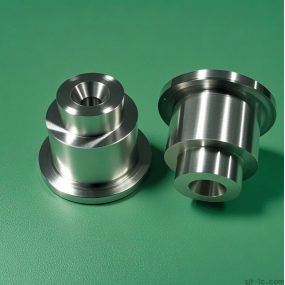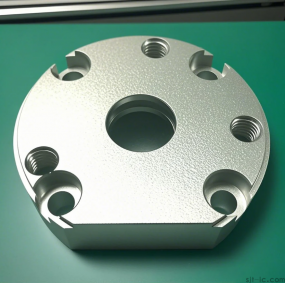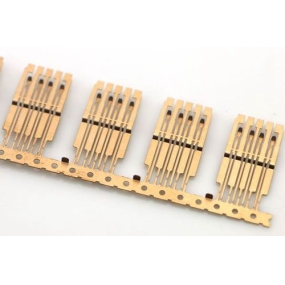The processing and molding of PTFE plastic raw materials can be roughly divided into four types: compression molding, rolling molding, injection molding, and secondary processing. Today, the editor will briefly introduce these four processing methods and precautions:
1、 Fluoroplastic rolling forming
PTFE film is roll formed, which can be divided into two processes: unidirectional rolling and multi-directional rolling. After rolling treatment, PTFE film changes from its original opaque self color to a semi transparent crystal color.
Unidirectional rolling is the process of rapidly processing a film that has been reheated to a transparent state by passing it through two equally rotating rollers of a rolling mill. The rolling ratio is controlled within the range of 1.5-2.5, and the general roller speed is 20 revolutions per minute.
Multi directional rolling is a forming process in which a sintered and quenched film is placed on a rolling mill for multi-directional rolling, gradually reducing the film thickness. The rolling ratio is in the range of 2-2.5. The temperature of the drum should be controlled between 150-200 ℃, and the steam pressure during steam heating should be between 0.5-0.9 megapascals. Rolling ratio is an important factor, both too large and too small are not good for the product. Sometimes it is necessary to repeatedly roll multiple times in order to press a product well.
2、 Fluoroplastic compression molding
Fluoroplastic molding can process plates, rods, sleeves, tapes, sealing rings, diaphragms, and parts with metal inserts.
Compression molding is divided into three steps: pre molding, sintering, and cooling. Preforming is the process of uniformly adding PTFE powder into a mold and pressing it at room temperature to form a dense preform (i.e. blank); Sintering is the process of heating a preform above its melting point, while cooling is the process of lowering the sintering temperature to room temperature.
Some fluoroplastics are formed by applying pressure once above their melting point temperature. This type of molding mold is called a hot press mold, and the corresponding PTFE mold is called a cold press mold.
When molding, attention should be paid to the influence of compression ratio (usually 4-6 for PTFE) and molding shrinkage rate (usually 2.6-4.5% for PTFE) on the product.
The raw material is polymerized resin by suspension method, and soft fine powder with a particle size of 20-500 microns is preferred. During the pressing process, it is necessary to "deflate" the air. The pre forming pressure is 17-35 megapascals, and the holding time depends on the thickness of the blank. For example, for a 100mm thick blank, it should be held for 15 minutes.
Attention should be paid during sintering: the heating rate can be set at 20-120 ℃/hour. The larger the product, the slower the heating rate. The sintering temperature of the suspension method resin is higher, at 370-380 ℃, while the sintering temperature of the dispersion method resin is lower, at 360-370 ℃. The sintering temperature is higher, and the shrinkage rate and porosity increase accordingly. The sintering time should be appropriately controlled.
Cooling: Generally, slow cooling is used at a rate of 15-25 ℃/hour. In special cases, such as a few thin plates with a thickness less than 5 millimeters or thin-walled tubes formed by pushing, fast cooling is used.
Sometimes the product is annealed at a temperature of 100-120 ℃ for 4-6 hours.
3、 Fluoroplastic injection molding
PFA (copolymer of tetrafluoroethylene and perfluoroalkyl vinyl ether), also known as meltable PTFE, can be injection molded. Its processing temperature is relatively wide, reaching up to 425 ℃, and its decomposition temperature is above 450 ℃. Generally, the processing temperature range is controlled between 330-410 ℃.
PFA has very low moisture absorption, at 0.03%, so it does not need to be dried. Before injection, the insert should be preheated to around 140 ℃. The temperature of the three stages of the injection material cylinder is 200-210 ℃, 300-310 ℃, and 350-410 ℃. The nozzle temperature is slightly lower than the higher temperature of the cylinder, and the mold temperature is 140-230 ℃. The injection pressure is 40-90 megapascals, and the injection speed should be slightly slower. The holding time should not be too long. The cooling time is 40-150 seconds.
4、 Secondary processing technology of fluoroplastics
Due to the processing characteristics of fluoroplastics, some products are difficult to form in one go and must undergo secondary processing to obtain usable finished products. Secondary processing techniques include cutting, welding, lining, blowing, etc.
Cutting: Similar to metal cutting methods, equipment includes lathes, drilling machines, planers, etc. Before cutting, the blank must be left for 24 hours before proceeding.
Lining: Generally, polytetrafluoroethylene and perfluoroalkoxy (written as F4 and F46) plastic are used to line black metal pipes and pipe fittings, which can be used as chemical anti-corrosion and corrosion-resistant materials.
Blowing: Products include corrugated tubes, heat shrink tubes, heat shrink films, etc. It is divided into continuous inflation and intermittent inflation.
Welding: divided into two types: hot press welding and hot air welding with welding rods. Hot press welding requires heating to 327 ℃ or above in a specially designed clamp and applying pressure to ensure successful welding.
Hot air welding rod welding uses PFA bars, which are heated and pressurized through PFA to connect two pieces together.
The billet of F46 heat shrinkable tube is prepared by water-cooled vacuum shaping method, with a pipe stretching ratio of 3-7, a molten cone length controlled at 10-20 millimeters, an inflation mold temperature of 80-160 ℃, an inflation pressure of 0.1-0.2 megapascals, and a traction line speed of 80-500 millimeters per minute. There are also inflated F4 spiral tubes.
For example, PTFE machine tool guide soft belt: using suspension method PTFE fine particle material, after crushing, passing through a 20 mesh sieve, the bronze or aluminum powder particle size is 200 mesh. For a 100mm high blank, hold the pressure for 5 minutes, release the gas three times in the middle, heat up at a rate of 50-60 ℃/hour during sintering, maintain the temperature at 320 ℃ for 1 hour, and cool down to 150 ℃ before removing from the furnace. Before turning the blank, it should be preheated to 80 ℃ and kept warm for one hour before proceeding. The soft tape should be treated with sodium naphthalene, including 51 grams of naphthalene, 100 milliliters of tetrahydrofuran, and an appropriate amount of metallic sodium. Soft tapes with a thickness of less than 1 millimeter should be immersed in the sodium naphthalene treatment solution for 1-3 minutes, and then rinsed with 90 ℃ hot water.
PTFE can be co mixed with polystyrene, polyimide, and poly (p-hydroxybenzoate), and filled with graphite, molybdenum disulfide, bronze powder, etc. It can be applied to hydraulic gates, and fluoroplastic 46 can be used on corrosion-resistant ball valves. Its molding temperature is 320-350 ℃, molding pressure is 3-30 megapascals, and shaping insulation temperature is 120-150 ℃.

Shenzhen EMAR Precision Technology is dedicated to high-precision CNC Machining, with processing materials mainly including aluminum alloy, steel parts, copper alloy, POM, Peek, and PTFE precision machining. The product application fields include optics, intelligent robots, optoelectronics, automotive, communication, security, surveying and other fields.


 Spanish
Spanish Arabic
Arabic French
French Portuguese
Portuguese Belarusian
Belarusian Japanese
Japanese Russian
Russian Malay
Malay Icelandic
Icelandic Bulgarian
Bulgarian Azerbaijani
Azerbaijani Estonian
Estonian Irish
Irish Polish
Polish Persian
Persian Boolean
Boolean Danish
Danish German
German Filipino
Filipino Finnish
Finnish Korean
Korean Dutch
Dutch Galician
Galician Catalan
Catalan Czech
Czech Croatian
Croatian Latin
Latin Latvian
Latvian Romanian
Romanian Maltese
Maltese Macedonian
Macedonian Norwegian
Norwegian Swedish
Swedish Serbian
Serbian Slovak
Slovak Slovenian
Slovenian Swahili
Swahili Thai
Thai Turkish
Turkish Welsh
Welsh Urdu
Urdu Ukrainian
Ukrainian Greek
Greek Hungarian
Hungarian Italian
Italian Yiddish
Yiddish Indonesian
Indonesian Vietnamese
Vietnamese Haitian Creole
Haitian Creole Spanish Basque
Spanish Basque











